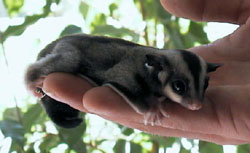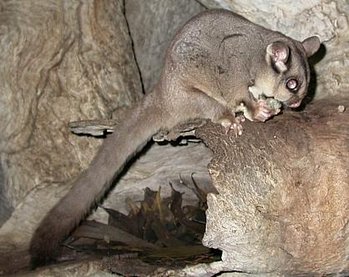Sugar Gliders
The Sugar Glider (Petaurus breviceps) is a small gliding possum native to eastern and northern mainland Australia, New Guinea, and the Bismarck Archipelago, and introduced to Tasmania. more...
Physical Description
It is around 16 to 20 cm (6.3 to 7.5 in) in length, with a slightly longer tail, and weighs between 90 and 150 grams (3 to 5.3 oz). The fur is generally pearl grey, with black and cream patches at the base of the pink ears. The tail tapers only moderately and the last quarter of it is black, often with a white tip. The muzzle is short and rounded. Northern forms tend to be brown coloured rather than grey and, as predicted by Bergmann's Rule, smaller.
The most noticeable features of its anatomy, however, are the twin skin membranes called patagiums which extend from the fifth finger of the forelimb back to the first toe of the hind foot. These are inconspicuous when the Sugar Glider is at rest — it merely looks a little flabby, as though it had lost a lot of weight recently — but immediately obvious when it takes flight. The membranes are used to glide between trees: when fully extended they form an aerodynamic surface the size of a large handkerchief.
The gliding membranes are primarily used as an efficient way to get to food resources. They may also, as a secondary function, help the Sugar Glider escape predators like goannas, introduced foxes and cats, and the marsupial carnivores that foxes, cats, and Dingos largely supplanted. The ability to glide from tree to tree is clearly of little value with regard to the Sugar Glider's avian predators, however, in particular owls and kookaburras.
Although their aerial adaptation looks rather clumsy and primitive by comparison with the highly specialised limbs of birds and bats, Sugar Gliders can glide for a surprisingly long distance — flights have been measured at over 50 meters (55 yd) — and steer effectively by curving one or other of the gliding membranes (patagium). They use their hind legs to thrust powerfully away from a tree, and when about 3 meters (3 yd) from the destination tree trunk, bring their hind legs up close to the body and swoop upwards to make contact with all four limbs together.
Habitat
Sugar Gliders can occupy any area where there are tree hollows for shelter and sufficient food. Their diet varies considerably with both geography and the changing seasons, but the main items are the sap of acacias and certain Eucalypts, nectar, pollen, and arthropods. They are difficult to see in the wild, being small, wary, and nocturnal, but a sure sign of their presence is the stripping of bark and tooth marks left in the soft, green shoots of acacia trees.
In suitable habitats, they are common, often reaching densities of 1 per 1,000 square meters provided that there are tree hollows available for shelter. They live in groups of up to 7 adults, plus the current season's young, all sharing a nest and defending their territory. Adult males mark the territory with saliva and with scent glands, and also mark members of the group with the scent produced by separate glands on the forehead and chest. Visitors which lack the appropriate scent marking are expelled violently. The dominant male mates more frequently with the female of the group than the other males, and does most of the scent marking. When an adult member of the group dies, it is normally replaced: by one of the group's own offspring if female, but by an outsider if male.
Read more at Wikipedia.org



